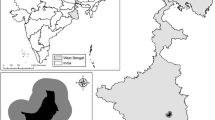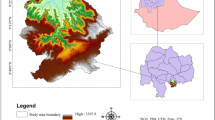Abstract
In recent times, there has been renewed interest in understanding the dynamics of land cover change and its relationship with several environmental parameters. This study assesses the interrelationship between land surface temperature (LST), normalized difference vegetation index (NDVI), normalized difference built-up index (NDBI), and land cover change in Amuwo-Odofin Local Government Area of Lagos State, Nigeria. Multi-temporal and multi-spectral Landsat imageries for years 2002, 2013, 2016, and 2019 served as the primary dataset. Using the parallelepiped classifier, the imageries were classified into five land cover classes — mixed vegetation, bare land, built-up area, water body, and wetland. The spectral indices (NDVI and NDBI) were computed and the LST was determined using a single-channel algorithm. Land cover transition matrices were calculated to examine the proportion of land cover change between classes, including the unchanged areas. Pearson’s correlation analysis enabled an analysis of the interdependence or interrelationship in the distribution of the parameters. From 2002 to 2019, the highest land cover transitions recorded were bare land to built-up area (12.64 km2), mixed vegetation to built-up area (21.55 km2), wetland to mixed vegetation (8.87 km2), and mixed vegetation to bare land (8.46 km2). There was a negative correlation between LST and NDVI, and between NDVI and NDBI. The distribution of the LST, NDVI, and NDBI varied correspondingly in accordance with land cover changes. The increase in built-up area could be the major driver of the observed changes in LST, NDBI, and NDVI, with an observed relationship that NDBI and LST values increase with increase in built-up areas.







source: Field survey, 2021)

source: Field survey, 2021)

source: Alani et al. 2020)
Similar content being viewed by others
Change history
18 June 2022
A Correction to this paper has been published: https://doi.org/10.1007/s12518-022-00446-y
References
Abiodun OE, Olaleye JB, Dokai AN (2005) Land use change analyses in Lagos State from 1984 to 2005. Spatial Information Processing II, May 2011, 18–22
Ajibola MO, Adewale BA, Ijasan KC (2012) Effects of urbanisation on Lagos wetlands. Int J Bus Soc Sci 3(17):310–318
Akinbobola A (2019) Simulating land cover changes and their impacts on land surface temperature in Onitsha, South East Nigeria. Atmos Climate Sci 09(02):243–263. https://doi.org/10.4236/acs.2019.92017
Akinyemi FO, Ikanyeng M, Muro J (2019) Land cover change effects on land surface temperature trends in an African urbanizing dryland region. City Environ Interact 4:100029. https://doi.org/10.1016/j.cacint.2020.100029
Alademomi AS, Okolie CJ, Daramola OE, Agboola RO, Salami TJ (2020) Assessing the relationship of LST, NDVI and EVI with land cover changes in the Lagos Lagoon environment. Quaestiones Geographicae 39(3):87–109. https://doi.org/10.2478/quageo-2020-0025
Alani RA, Ogunmoyela OM, Okolie CJ, Daramola OE (2020) Geospatial analysis of environmental noise levels in a residential area in Lagos. Nigeria Noise Mapp 2020(7):223–238. https://doi.org/10.1515/noise-2020-0019
Alexander C (2020) Normalised difference spectral indices and urban land cover as indicators of land surface temperature (LST). Int J Appl Earth Obs Geoinformation 86(October 2019):102013
Anderson JR (1971) Land use classification schemes used in selected recent geographic applications of remote sensing. Photogramm Eng 37(4):379–387
Babalola OS, Akinsanola AA (2016) Change detection in land surface temperature and land use land cover over Lagos metropolis, Nigeria. J Remote Sens GIS 5(3). https://doi.org/10.4172/2469-4134.1000171
Choudhury D, Das K, Das A (2019) Assessment of land use land cover changes and its impact on variations of land surface temperature in Asansol-Durgapur Development Region. Egypt J Remote Sens Space Sci 22(2):203–218. https://doi.org/10.1016/j.ejrs.2018.05.004
Cummings S (2007) An analysis of surface temperature in San Antonio, Texas. Term Project. EES5053/ES4093: Remote Sensing, UTSA.
Das S, Angadi DP (2020) Land use-land cover (LULC) transformation and its relation with land surface temperature changes: a case study of Barrackpore Subdivision, West Bengal, India. Remote Sensing Applications: Society and Environment 19(May):100322. https://doi.org/10.1016/j.rsase.2020.100322
Das N, Mondal P, Sutradhar S, Ghosh R (2020) Assessment of variation of land use/land cover and its impact on land surface temperature of Asansol subdivision. Egypt J Remote Sens Space Sci S1110982320300272. https://doi.org/10.1016/j.ejrs.2020.05.001
Deng Y, Wang S, Bai X et al (2018) Relationship among land surface temperature and LUCC, NDVI in typical karst area. Sci Rep 8:641. https://doi.org/10.1038/s41598-017-19088-x
Fathizad H, Tazeh M, Kalantari S, Shojaei S (2017) The investigation of spatiotemporal variations of land surface temperature based on land use changes using NDVI in southwest of Iran. J Afr Earth Sc 134(2017):249–256. https://doi.org/10.1016/j.jafrearsci.2017.06.007
Ferrelli F, Bustos M, Huamantinco-Cisneros M, Piccolo M (2015) Utilization of satellite images to study the thermal distribution in different soil covers in Bahia Blanca city (Argentina). Revista De Teledetección 44:31–42
Grigoras G, Uritescu B (2019) Land use/land cover changes dynamics and their effects on surface urban heat island in Bucharest, Romania. Int J Appl Earth Obs Geoinf 80(February):115–126. https://doi.org/10.1016/j.jag.2019.03.009
Guha S et al (2018) Analytical study of land surface temperature with NDVI and NDBI using Landsat 8 OLI and TIRS data in Florence and Naples city, Italy.". Eur J Remote Sens 51(1):667–678
Guha S, Govil H, Gill N, Dey A (2020) Analytical study on the relationship between land surface temperature and land use/land cover indices. Ann GIS 26(2):201–216. https://doi.org/10.1080/19475683.2020.1754291
Han JC, Huang Y, Zhang H, Wu X (2019) Characterization of elevation and land cover dependent trends of NDVI variations in the Hexi region, northwest China. J Environ Manag 232(November 2018):1037–1048. https://doi.org/10.1016/j.jenvman.2018.11.069
Hua AK, ** OW (2018) The influence of land-use/land-cover changes on land surface temperature: a case study of Kuala Lumpur metropolitan city. Eur J Remote Sens 51(1):1049–1069. https://doi.org/10.1080/22797254.2018.1542976
Jaber SM (2019) On the relationship between normalized difference vegetation index and land surface temperature: MODIS-based analysis in a semi-arid to arid environment. Geocarto Int 0(1010–6049):1–19. https://doi.org/10.1080/10106049.2019.1633421
Kabano P, Lindley S, Harris A (2021) Evidence of urban heat island impacts on the vegetation growing season length in a tropical city. Land scape and Urban Plan 206:103989
L3Harris Geospatial (2020). Gram-Schmidt pan sharpening. https://www.l3harrisgeospatial.com/docs/gramschmidtspectralsharpening.html#:~:text=ENVI%20performs%20Gram%2DSchmidt%20spectral,lower%20spatial%20resolution%20spectral%20bands.&text=Swap**%20the%20high%20spatial%20resolution,the%20pan%2Dsharpened%20spectral%20bands. Accessed 4 Aug 2021
Lagos Bureau of Statistics (2019) Abstract of local government statistics. https://mepb.lagosstate.gov.ng/wp-content/uploads/sites/29/2020/08/Abstract-of-Local-Government-Statistics-Y2019.pdf. Accessed 30 Sept 2020
Malik MS, Shukla JP, Mishra S (2019) Relationship of LST, NDBI and NDVI using landsat-8 data in Kandaihimmat watershed, Hoshangabad. India Indian J Geo-Marine Sci 48(1):25–31
Marzban F, Sodoudi S, Preusker R (2018) The influence of land-cover type on the relationship between NDVI–LST and LST-Tair. Int J Remote Sens 39(5):1377–1398. https://doi.org/10.1080/01431161.2017.1402386
Masek JG, Vermote EF, Saleous NE, Wolfe R, Hall FG, Huemmrich KF, Gao F, Kutler J, Lim T-K (2006) A Landsat surface reflectance data set for North America, 1990–100. IEEE Geosci Remote Sens Lett 3:68–72
Nse OU, Okolie CJ, Nse VO (2020) Dynamics of land cover, land surface temperature and NDVI in Uyo Capital City. Nigeria Sci Afr 10(2020):00599. https://doi.org/10.1016/j.sciaf.2020.e00599
Nwilo PC, Olayinka DN, Okolie CJ, Emmanuel EI, Orji MJ, Daramola OE (2020) Impacts of land cover changes on desertification in northern Nigeria and implications on the Lake Chad Basin. J Arid Environ 181(April):104190. https://doi.org/10.1016/j.jaridenv.2020.104190
Obiefuna JN, Nwilo PC, Atagbaza AO, Okolie CJ (2013) Spatial changes in the wetlands of Lagos/Lekki Lagoons of Lagos. Niger J Sustain Dev 6(7):123–133. https://doi.org/10.5539/jsd.v6n7p123
Obiefuna JN, Nwilo PC, Atagbaza AO, Okolie CJ (2013) Land cover dynamics associated with the spatial changes in the Wetlands of Lagos/Lekki Lagoon system of Lagos. Niger J Coast Res 29(3):671–679. https://doi.org/10.2112/JCOASTRES-D-12-00038.1
Obiefuna JN, Nwilo PC, Okolie CJ, Emmanuel EI, Daramola O (2018) Dynamics of land surface temperature in response to land cover changes in Lagos metropolis. Niger J Environ Sci Technol 2(2):148–159. https://doi.org/10.36263/nijest.2018.02.0074
Obiefuna JN, Okolie CJ, Nwilo PC, Daramola OE, Isiofia LC (2021) Potential influence of urban sprawl and changing land surface temperature on outdoor thermal comfort in Lagos State. Nigeria Quaestiones Geographicae 40(1):5–23. https://doi.org/10.2478/quageo-2021-0001
Oguz H (2013) LST calculator: A program for retrieving land surface temperature from Landsat TM/ETM+ imagery. Environ Eng Manag J 12(3):549–555
Qin Z, Karnieli A, Berlinier P (2001) A mono-window algorithm for retrieving land surface temperature from Landsat TM data and its application to the Israel-Egypt border region. Int J Remote Sens 22(18):3719–3746
Schott JR, Volchok WJ (1985) Thematic mapper thermal infrared calibration. Photogramm Eng Remote Sens 51:1351–1357
Siqi J, Yuhong W (2020) Effects of land use and land cover pattern on urban temperature variations: a case study in Hong Kong. Urban Climate 34(August):100693. https://doi.org/10.1016/j.uclim.2020.100693
Tepanosyan G, Muradyan V, Hovsepyan A, Pinigin G, Medvedev A, Asmaryan S (2020) Studying spatial-temporal changes and relationship of land cover and surface urban heat island derived through remote sensing in Yerevan, Armenia, building and environment (2020) https://doi.org/10.1016/j.buildenv.2020.107390.
UNFPA (2020) Delivering in a pandemic annual report 2020
USGS (2015) Landsat 8 (L8) Data users handbook, version 1.0. LSDS-1574. Department of the Interior, U.S. Geological Survey
Vermote E, Justice C, Claverie M, Franch B (2016) Preliminary analysis of the performance of the Landsat 8/OLI land surface reflectance product. Remote Sens Environ 185:46–56
Weng Q, Lu D, Schubring J (2004) Estimation of land surface temperature – vegetation abundance relationship for urban heat island studies. Remote Sens Environ 89(4):467–483
Wukelic GE, Gibbons DE, Martucci LM, Foote HP (1989) Radiometric calibration of Landsat thematic mapper thermal band. Remote Sens Environ 28:339–347
Yusuf KA, Oluwole S, Abdusalam IO, Adewusi GR (2013) Spatial patterns of urban air pollution in an industrial estate, Lagos, Nigeria spatial patterns of urban air pollution in an industrial estate, Lagos. Niger Int J Eng Inventions 2(4):1–9
Zareie S, Khosravi H, Nasiri A (2016) Derivation of land surface temperature from Landsat thematic mapper (TM) sensor data and analyzing relation between land use changes and Surface Temperature. Solid Earth Discuss. 10.5194/se-2016-22,201
Zha Y, Gao J, Ni S (2003) Use of normalized difference built-up index in automatically map** urban areas from TM imagery. Int J Remote Sens 24(3):583–594. https://doi.org/10.1080/01431160304987
Acknowledgements
The authors are grateful to the USGS for access to the Landsat imageries and the USGS EROS Centre for the Landsat spectral indices used in this research. Also, credits are due to the team that conducted the original research on the Landsat surface reflectance products (Masek et al., 2006; Vermote et al., 2016). The authors also thank the management of the Department of Surveying and Geoinformatics at the University of Lagos for providing a conducive research environment within which the study was conducted. Special thanks to Nkechi Onyiagu and Julius Enakirerihi for their help with acquiring field pictures.
Author information
Authors and Affiliations
Corresponding author
Ethics declarations
Conflict of interest
The authors declare no competing interests.
Additional information
The original online version of this article was revised: This article was inadvertently published shortly after the initial submission of correction. There had been a correction in Eq. 3 and Tables 8, 9, 10 when the whole team of authors finalized the corrections. Given here are the corrected equation and tables.
Rights and permissions
About this article
Cite this article
Alademomi, A.S., Okolie, C.J., Daramola, O.E. et al. The interrelationship between LST, NDVI, NDBI, and land cover change in a section of Lagos metropolis, Nigeria. Appl Geomat 14, 299–314 (2022). https://doi.org/10.1007/s12518-022-00434-2
Received:
Accepted:
Published:
Issue Date:
DOI: https://doi.org/10.1007/s12518-022-00434-2




